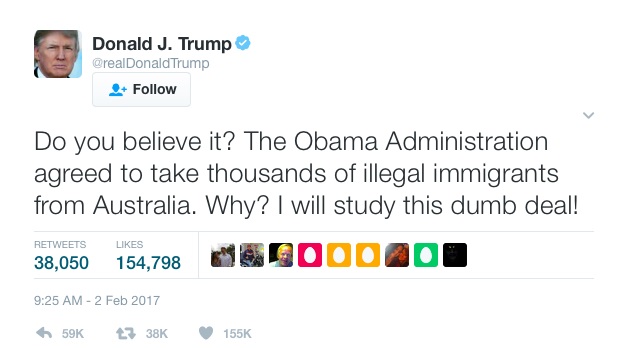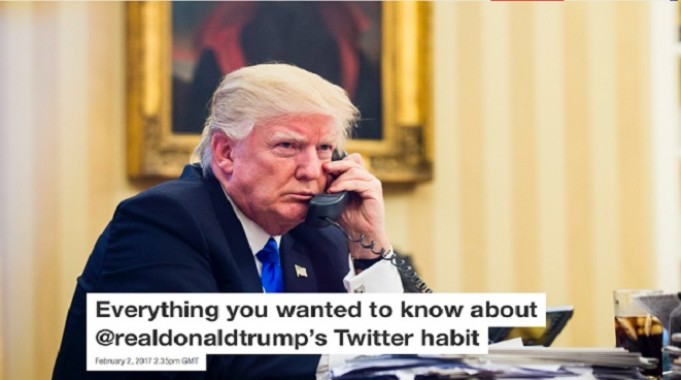Dissecting Donald Trump’s language on Twitter
Reprinted from The Conversation
Another day, another tweet, another incident. This time Donald Trump, the prolific and seemingly indiscriminate tweeter who just happens to be leader of the free world has damaged diplomatic relations with Australia by raging against a refugee resettlement deal that had been struck in the dying days of the Obama administration.
When Australian prime minister, Malcolm Turnbull, called Trump to seek clarification about the deal – which involved resettlement in the US of up to 1,250 asylum seekers held by Australia in an off-shore detention centre on the pacific island of Nauru – Trump was harsh and abrupt, ending the call suddenly after less than half the allotted hour.
As is his wont, he later used Twitter to relay his thoughts:

The phrasing, punctuation, word choices and tone evident in this one tweet are indicative of an overall style of communication now familiar to Trump followers.
First, there are the factual inaccuracies – these are asylum seekers not illegal immigrants. Then there is the mode of address – Trump often tweets as if addressing an individual in conversation (“do you believe it?”). This of course helps to create the illusion of intimacy and shared experience. The point is that this is supposed to be so far away from conventional political discourse as to be thought refreshing and different. We tend not to expect statesmen to be so dismissive of the political process and use the vernacular – that is to say the language (“dumb deal”) normally associated with “ordinary” people.
Then there is Trump’s overuse of capital letters and the exclamation mark. Style guides tell us this indicates immaturity and excessive excitement – but exclamation marks have become, with the prevalence of emails and texts, ubiquitous signifiers of the writer’s mood. As Jean Berko Gleason points out: “They can mitigate the brusqueness of a brief reply by indicating the writer’s enthusiasm, sincerity, surprise – it all depends on the situation.”
Cutting out media middlemen
These tweets are not indiscriminate and ill thought-out after all. It is certain that Trump and his advisers realise the value in bypassing the “crooked” mainstream media to speak directly to their base in a language they understand. This is a president who is acutely aware of the power of social media. In November, he told ABC’s 60 Minutes that:
I find it tremendous. It’s a modern form of communication. There should be nothing you should be ashamed of … the fact that I have such power in terms of numbers with Facebook, Twitter, Instagram, et cetera. I think it helped me win all of these races where they’re spending much more money than I spent.
On Twitter, Trump is behaving like the celebrity he is – cutting out the troublesome middleman to promote himself and his policies without the inconvenience of long-form explanation. The limit of 140 characters is perfect for communicating emotion rather than nuance. The widely respected US academic and media commentator Jay Rosen has it right, in my view. Seeing what Trump communicates as just “tweets” is an illusion which doesn’t take them seriously enough:
These are public statements from the president-elect. Bulletins from the top. Naming them for their means of delivery (Twitter) doesn’t help. They can’t be ignored any more than an announcement on whitehouse.gov can be disregarded.
Who Trump follows
At the time of writing, Trump has 23.3m twitter followers – and, while clearly a great many of these will not be supporters it’s clear that a huge number will be his base and many of them will retweet his thoughts to an even wider audience. So who needs the mainstream media?
Trump obviously feels that he does not – it’s enlightening to note that of the meagre 40 people @realdonaldtrump follows, only a select few can be called journalists – or, perhaps more accurately “media workers”. Yes, among the family members and representatives of various Trump business interests are the names of Bill O’Reilly, Laura Ingraham, Sean Hannity and Eric Bolling, all of whom in some way or another are associated with Fox News.
Fox News (current chairman and acting CEO, Rupert Murdoch) has been actively championing the political ambitions of Trump for some five years and despite the occasional spat, the admiration is mutual. This week, during a speech ostensibly about Black History Month, Trump stated:
I don’t watch CNN … I don’t like watching fake news … But Fox has treated me very nice, wherever Fox is, thank you.
This is of great importance because as Politico reports, January marked 15 years for Fox News as the top-rated cable news channel in the US. It averages 2.8m viewers in primetime and 1.8m viewers in a total day. Its ratings are rising, too – by double digits compared to this same month last year.
Perhaps the journalist who is closest to Trump at this present time is Sean Hannity. It was to this trusted supporter that Trump granted his first cable news interview as president – and it is certainly Hannity who has vigorously and effectively outlined Trump’s overall view of the US maintream media. Hannity sees the 2016 election as a watershed in history during which the credibility of the mainstream media was destroyed. He clearly holds the profession of which he is part in outright contempt. In an interview with Politico he stated:
The media has a bunch of overpaid, out of touch, lazy millionaires that have nothing but contempt for the people that do make this country great. I am not one of those people.
But social media is the area in which Trump reigns supreme and as Gavin Fernando has written, he has revolutionised the social media game for politicians. It is now the collective responsibility of journalists (whoever is occupying the White House) to scrutinise the content of tweets by politicians in much the same way they would any other political statement.
One final thing which may be of interest to British readers of The Conversation. Trump follows only one British journalist: Piers Morgan.
John Jewell is Director of Undergraduate Studies, School of Journalism, Media and Cultural Studies, Cardiff University.







